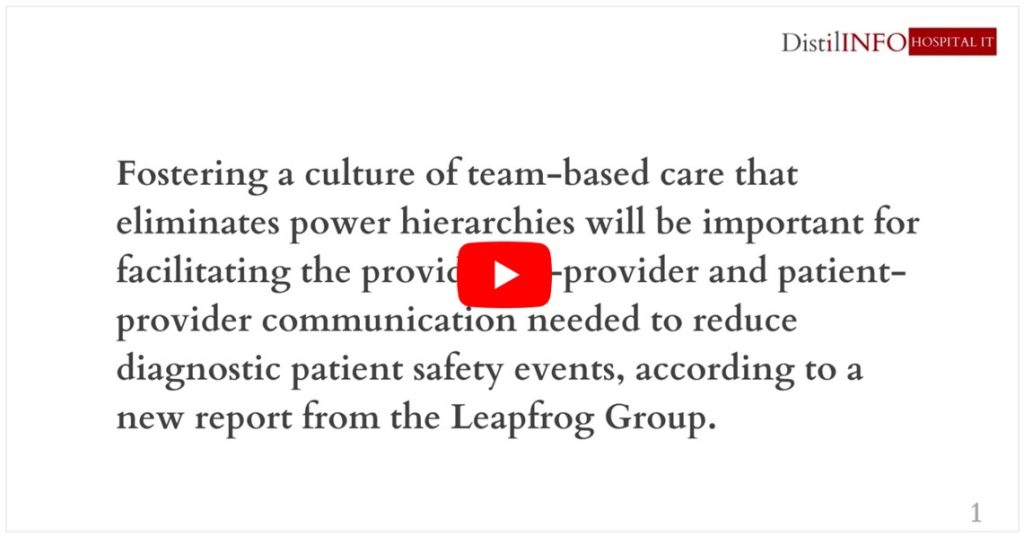
Fostering a culture of team-based care that eliminates power hierarchies will be important for facilitating the provider-to-provider and patient-provider communication needed to reduce diagnostic patient safety events, according to a new report from the Leapfrog Group.
The report, an advanced copy of which was sent to PatientEngagementHIT via email, particularly advocated for a healthcare environment in which patients and family members feel comfortable flagging diagnostic errors and other patient safety concerns; creating a communication system that lets clinicians review test results before results are sent to patients; and creating an organization advisory team to carry out diagnostic quality and safety programs.

This report comes as the medical industry faces worsening patient safety trends after years of improvement. In May 2022, a report from the HHS Office of Inspector General (OIG) found that patient safety was a problem for nearly a quarter of Medicare beneficiaries.
The current downturn in patient safety is likely the result of the COVID-19 crisis, with some preliminary data suggesting there’s hope for improvement. Before the pandemic, patient safety rates were improving, the Agency for Healthcare Research and Quality (AHRQ) reported in July 2022.
With concerted effort, the medical industry can return to pre-pandemic patient safety event rates and continue trending toward zero harm.
Reducing diagnostic errors and patient safety issues related to diagnostics will be a key part of that equation, the Leapfrog Group said. The organization defined a diagnostic error as a delayed, wrong, or missed diagnosis or one that was not communicated properly to the patient.
Somewhere between 40,000 and 80,000 deaths every year stem from diagnostic errors, the Leapfrog Group said, and more than 250,000 Americans experience a diagnostic error in the hospital.
“Clinicians and hospital leaders tell us they know diagnostic errors are harming too many patients, but they are less clear on how to fix the problem,” Leah Binder, Leapfrog president and CEO, said in a public statement emailed to journalists. “Thanks to the incredible leadership of the multi-stakeholder group Leapfrog has convened, hospitals now have clarity on the steps to take. The faster hospitals act, the more lives they can save.”
The Leapfrog Group partnered with leadership from the Society to Improve Diagnosis in Medicine and patient safety experts to outline 29 best practices for reducing the rate of diagnostic error and adverse patient safety events. Critically, these recommendations include strong patient-provider communication, a central part of overall patient safety best practices, the Leapfrog Group wrote.

“Safe, high-quality hospital care begins with patients receiving the right diagnosis, communicated accurately and in a timely manner,” the report noted. “In practice, this process too often fails. Communication breaks down, diagnoses are inaccurate or informed by incorrect information, and patients suffer.”
Of course, organizational communication will be central to stemming those communication breakdowns, the report indicated. Healthcare organizations need good systems for documenting patient data and diagnosis, as well as facilitating provider-to-provider communication and care coordination. Additionally, organizations need ways to remedy mistakes; one of the recommendations suggested creating a system for correcting information or diagnosis within the EHR.
Organizations should also consider staff handoffs and systems for resolving discrepancies between providers or care teams.
But perhaps most notably, the report emphasized the patient engagement support necessary to reduce diagnostic errors and reduce adverse patient safety events.
Foremost, the report acknowledge that patients and their family caregivers need to be empowered to report potential diagnostic errors or other patient safety red flags. That means providers need to use their communication skills to ease perceived power hierarchies as well as deliver adequate patient education to empower patients and family members.

The report authors added that patients need access to the right tools to engage in their care. Access to the patient portal, and provider recommendation to use it, can help. Additionally, offering access to medical interpreters for patients with limited English proficiency (LEP) will be key.
Moreover, providers must be mindful of how they discuss diagnoses with patients. Using clear language that considers patient health literacy is crucial, as is reviewing and discussing test results in a timely manner.
And when a patient has a pending test result or diagnosis upon discharge, providers should tell them exactly which test results are in flux and how patients can view results when they become available. Providers may follow up with patient outreach to close the diagnosis loop, the Leapfrog Group advised.
The Leapfrog Group said it will use the findings issued in this report to learn more about how hospitals are safeguarding against diagnostic errors. After selecting some of the 29 recommendations outlined in the report, the Leapfrog Group will survey volunteer hospitals in a national pilot survey in the fall of 2022.
That pilot survey will inform efforts to develop a new section of the Leapfrog Hospital Survey, which the organization said it intends to launch in 2024. The Leapfrog Group also said SIDM will build tools and training modules to help hospitals adopt the best practices outlined in the report.
Source: PatientEngagement HIT

Leave a Reply